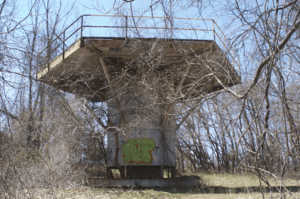Riker Hill Art Park facts for kids
Riker Hill Art Park is a special place in Livingston, Essex County, New Jersey. It used to be a secret Nike Missile base during the Cold War. Now, it's a lively community where artists create amazing things! It's part of the Riker Hill Complex, which also includes the Walter Kidde Dinosaur Park and Becker Park.
At the Art Park, artists have studios where they work on different types of art. This includes painting, ceramics, glass blowing, woodworking, and sculpture. You can also find cool outdoor sculptures around the park.
Contents
A Look Back: The Park's History
The land where Riker Hill Art Park stands has a long and interesting past. It has seen everything from ancient dinosaurs to Cold War defenses.
Dinosaurs and Early Settlers
About 200 million years ago, tiny dinosaurs walked here, leaving their footprints behind. These footprints were found in the late 1960s!
Later, in the 1700s, a person named Peter Riker and his mother lived on the hill. People told stories about them, and even today, the hill is named after the Riker family.
The Cold War and Missile Base
From 1954 to 1974, Riker Hill was a very important spot during the Cold War. The United States Army had a system of anti-aircraft missile sites called the Nike Air Defense System. These sites were built around big US cities to protect them from enemy planes.
Riker Hill was perfect for one of these sites because it's one of the highest points in the area. This meant it had a clear view for its radar station, which was called "Control Area, Nike Battery NY-80." This station would track enemy planes and guide missiles to them if there was an attack.
By the 1970s, new weapons like intercontinental missiles made the old bomber planes and the Nike system less important. So, the Army closed the NY-79/80 Nike base.
From Military Base to Park Land
In 1974, the Army closed the Riker Hill Nike Battery Control Area NY-80. The land was no longer needed by the government. Essex County wanted the land and bought the 42-acre site for just $1 in 1974. The county officially took ownership in 1977.
For a few years, Essex County ran a small museum there. It showed off the dinosaur footprints and fossils found nearby. But the museum closed because not many people visited, and there wasn't enough money to keep it going.
Artists Create the Art Park
The old military buildings were not being used much. They were just cinderblock buildings with old radar towers. But some local artists and people from the Essex County Parks Department had a great idea. They wanted to turn the site into a place for artists' studios.
In 1982, the Parks Department put the Riker Hill site under its Division of Cultural Affairs. However, there was no money to help. The artists would have to support the Art Park themselves. They planned to do this by teaching classes and selling their artwork.
When the artists first arrived, most of the buildings were in bad shape. They had no heat, water, electricity, roofs, windows, or doors. It took a lot of hard work and creativity to change the old military base into a lively place for art.
Building the Park Together
The artists worked together to fix up the buildings. Building #509 was the first one they used because it was the only one with heat. Local companies helped by giving them lights, electrical supplies, furniture, and even windows and doors.
In the first three years, five outdoor sculptures were given to Riker Hill. These sculptures helped make it feel like a true art park. By the summer of 1986, all the buildings were full of artists. They even started a popular Summer Performing Arts Series. It was so popular that a stage had to be built the next year for bigger shows, like the Livingston Symphony Orchestra's first outdoor concert.
The Park Grows in the 1990s
Riker Hill Art Park continued to host many popular events. These included "Jazz Under the Stars," "Shakespeare in the Park," and an annual open house where people could visit the studios.
In 1991, three tall, shiny "Whale Tail" sculptures were given to the park. These 20-foot-tall sculptures became famous symbols of the park. That same year, a graphics arts studio and a ceramics studio were added. By the mid-1990s, Riker Hill was a full art center. It had 35 studios for things like glass blowing, clay, photography, jewelry making, weaving, steel sculpting, painting, and woodworking.
Riker Hill Today
Riker Hill Art Park is still growing and changing. The artists and the Essex County Department of Parks, Recreation, and Cultural Affairs work hard to offer unique art experiences.
One of the park's founders, Ben Schaffer, once wrote about the special feeling at Riker Hill. He said, "One of the magical charms of Riker Hill is the ability of the artists to work with each other." He explained how a jewelry artist started working with a potter, and soon their designs blended together. This shows how artists at Riker Hill inspire each other and create amazing things together.
Images for kids



